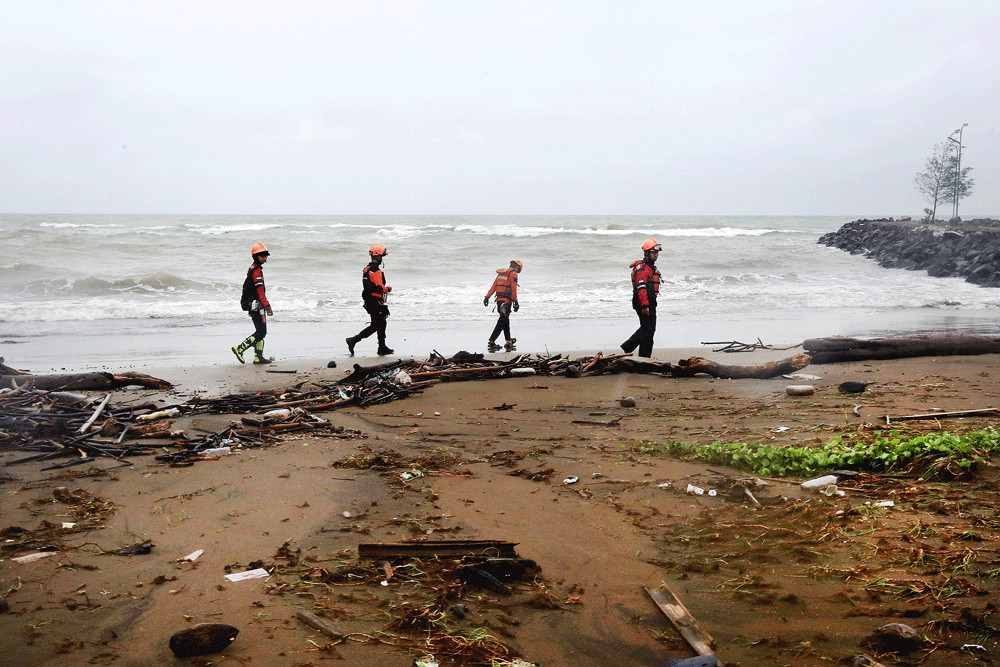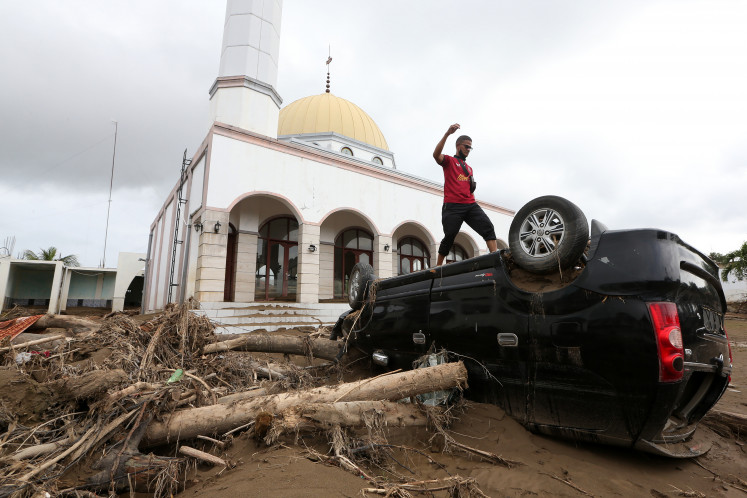Popular Reads
Top Results
Can't find what you're looking for?
View all search resultsPopular Reads
Top Results
Can't find what you're looking for?
View all search resultsHeed lessons from Indonesia’s out-of-the-blue tsunami disaster
Proper attention and vigilance are needed against sudden tsunami that strike without any obvious signs.
Change text size
Gift Premium Articles
to Anyone
 Grim task: Search and rescue team members scour Carita Beach for victims of the Sunda Strait tsunami in Pandeglang, Banten, on Thursday. Saturday’s tsunami, which was triggered by eruptions from Anak Krakatau, is reported to have killed 430 people and injured 1,495. As many as 159 people are missing, with 21,991 others displaced. (The Jakarta Post/Dhoni Setiawan )
Grim task: Search and rescue team members scour Carita Beach for victims of the Sunda Strait tsunami in Pandeglang, Banten, on Thursday. Saturday’s tsunami, which was triggered by eruptions from Anak Krakatau, is reported to have killed 430 people and injured 1,495. As many as 159 people are missing, with 21,991 others displaced. (The Jakarta Post/Dhoni Setiawan )
People must never assume that a tsunami strikes only after an earthquake.
A huge tsunami generated in the Sunda Strait west of Java Island in Indonesia suddenly slammed into resort areas along the coast.
Hotels and homes were destroyed, and many people were swept away. More than 500 people died or remain missing, and at least 20,000 people have taken refuge in evacuation shelters and other places. More international aid will be essential for the affected area.
A distinguishing feature of this tragedy is that an earthquake, which can be a precursor of a tsunami, did not occur.
The tsunami struck about 20 minutes after an island volcano in the strait erupted. It appears that a large chunk of the volcano collapsed into the sea due to the eruption, triggering the tsunami. A Japanese Earth observation satellite captured images showing that about half of the island had disappeared.
Residents living along the coast were helpless against the unexpected tsunami.
In September, a large tsunami that struck an island in northeastern Indonesia claimed at least 2,000 lives. The earthquake that occurred at that time was a type considered unlikely to create a tsunami, but the tremors set off massive landslides. Some of the landslides occurred on the seabed, causing the tsunami.
The damage caused by this string of unusual tsunami is certainly not something Japan should dismiss as someone else’s misfortune. Both Japan and Indonesia are surrounded by bodies of water. Earthquakes and volcanic eruptions frequently occur in both nations. One lesson from the latest disaster is that proper attention and vigilance is needed against sudden tsunami that strike without any obvious signs.
Similar cases in Japan
Many such cases also have occurred in Japan in the past. The foremost example is the huge tsunami generated in the Ariake Sea in 1792.
This tsunami occurred when one side of Mt. Mayu on the Shimabara Peninsula in Nagasaki Prefecture broke off and collapsed into the sea. The tsunami, which also inundated the coast of Kumamoto Prefecture on the opposite side of the Ariake Sea, killed about 15,000 people. This disaster is known in Japanese as “Shimabara Taihen Higo Meiwaku” meaning people in the Higo area suffered from a huge trouble that occurred on the opposite shore in the Shimabara area.
Another extraordinary case was the tsunami that struck the Sanriku coast in 1896. Because an earthquake caused only light shaking, there was not much alarm about a tsunami. But then giant tsunami engulfed the coast, killing more than 20,000 people.
In recent years, there has been concern that a volcanic eruption of Nishinoshima island in the Ogasawara Islands could cause the island to collapse and trigger a tsunami.
Various factors can create tsunami. Examining the traces left by past tsunami in coastal areas and elsewhere and considering the mechanisms that generated the waves in affected areas also will be useful in preparing more effective countermeasures.
Quickly detecting a tsunami also is vital. When an earthquake occurs along a known active fault, the Japan Meteorological Agency swiftly issues a tsunami warning. In addition to that, the key is whether tide gauges, swell meters and submarine tsunami meters positioned along and off the coast in many places can detect any changes.
Prompt evacuation is a cornerstone of mitigating a disaster. Technologies that can sense the risk from the subtle signs of a tsunami will be needed.
This article appeared on The Japan News newspaper website, which is a member of Asia News Network and a media partner of The Jakarta Post









